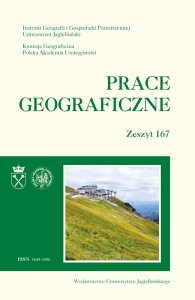Czasowo-przestrzenna ewolucja i czynniki kształtujące rozmieszczenie przemysłu wysokiej techniki w polskich gminach
Spatio-temporal evolution and factors behind the spatial distribution of the high-tech industry in Polish communes
Author(s): Grzegorz Micek, Maciej Pietrzko, Łukasz FiedeńSubject(s): Human Geography
Published by: Wydawnictwo Uniwersytetu Jagiellońskiego
Keywords: location factors; location quotient; Poland; high technology industry; spatial distribution;
Summary/Abstract: Research on the spatial distribution of high technology industries has been the subject of geographers’ studies for a long time. However, in recent years there has been a lack of analyses in Poland which would allow to determine the spatio-temporal variability of advanced economic activities and to verify the determinants of their occurrence. On the basis of GUS data and variables describing transport accessibility, principal component and regression analyses were carried out to identify the location factors of the high-tech industry at the local (commune) level. It is still significantly concentrated in the areas of large cities. Nevertheless, the number of enterprises of the analysed industries in suburban areas increases significantly, which indicates the processes of economic suburbanisation of advanced economic activities. Unfortunately, apart from historically shaped centre of the high technology industry and limited number of new centres, the analysed industries do not develop in medium and small towns and their surroundings. Due to strong emigration, underdeveloped human capital and insufficient transport accessibility, high technology industries have so far generally not appeared in non-metropolitan areas, too. The analysed high-tech industries are concentrated in areas with high values of the entrepreneurship index, high living standards and relatively good transport accessibility. The key variable determining the development of the analysed industries is the situation on the labour market, both in terms of the level of professional activity of the population, the sought-after qualifications of the staff, as well as the level of inter-firm mobility of the staff.
Journal: Prace Geograficzne
- Issue Year: 2022
- Issue No: 167
- Page Range: 91-117
- Page Count: 27
- Language: Polish

